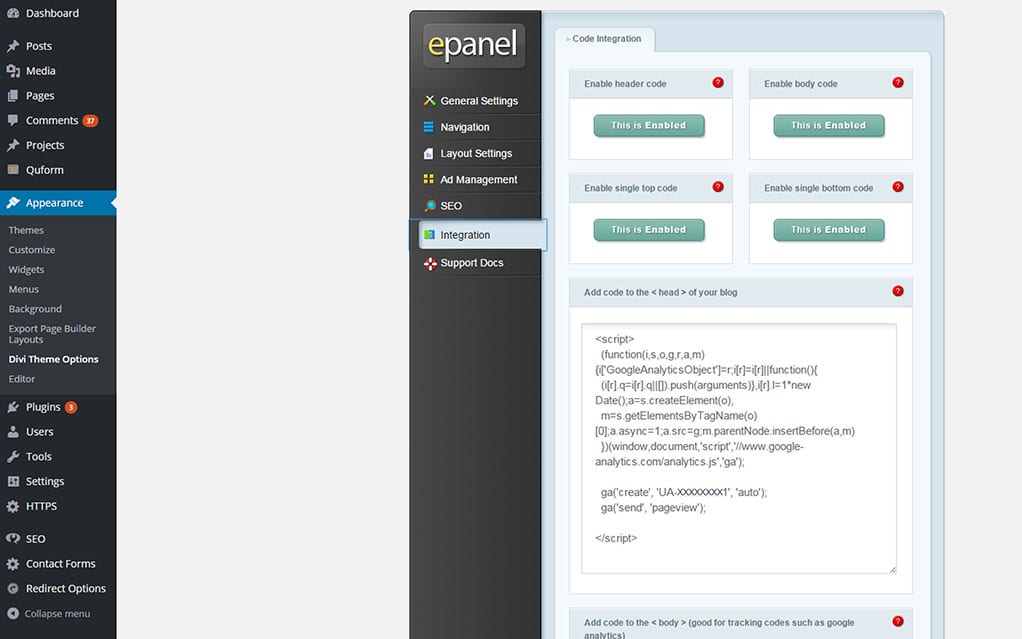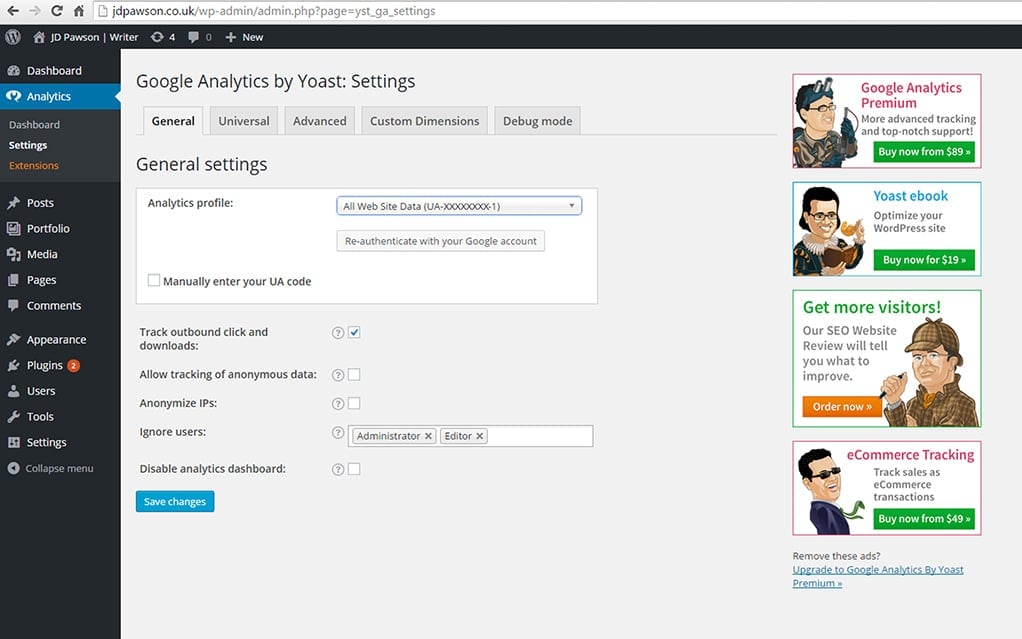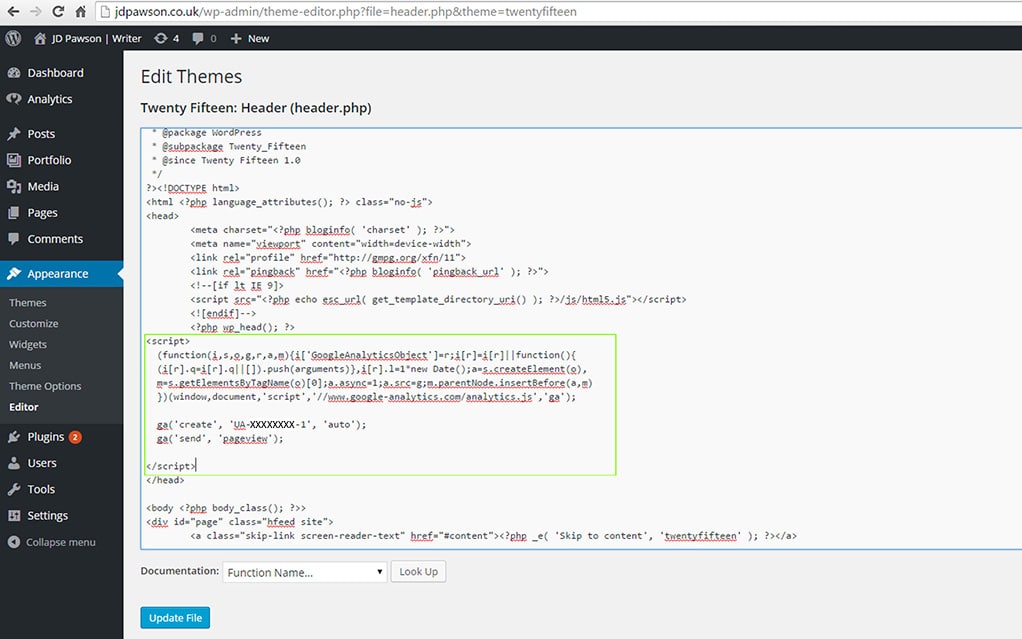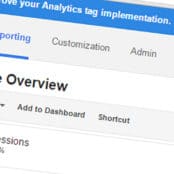
Analytics… a word that many creative types shy away from. But understanding how your website performs is not only interesting, it’s imperative to knowing if your site is being visited, who’s visiting it, what’s working, and what’s not. It can help you identify areas – either in terms of design or content – that need work, and ensure that you’re speaking to your target audience.
There are a number of tools that allow you to analyze your site’s traffic; Google Analytics is, perhaps unsurprisingly, the most well known and many would argue the best available. It offers a wealth of options to dissect information about the people visiting your site; where they found you, how long they stayed, and even demographics such as age, gender, location, and browser preference. There is a fairly steep learning curve for some of the more in-depth analysis options, but top level data is easy to access, filter, and consume.
Thankfully, setting up Google Analytics is a straightforward process for those using WordPress sites. Widely speaking, you have three main options for implementing Google Analytics in WordPress, depending on the theme and plugins you have installed. But before we look at those options, the first thing to do is set yourself up with an analytics account at www.google.com/analytics/.
The step by step process will take you through setting up your site, and by the end of it, you’ll be presented with some nifty code that needs to find its way into your site. It should look something like this:
<script>
(function(i,s,o,g,r,a,m){i['GoogleAnalyticsObject']=r;i[r]=i[r]||function(){
(i[r].q=i[r].q||[]).push(arguments)},i[r].l=1*new Date();a=s.createElement(o),
m=s.getElementsByTagName(o)[0];a.async=1;a.src=g;m.parentNode.insertBefore(a,m)
})(window,document,'script','//www.google-analytics.com/analytics.js','ga');
ga('create', 'UA-XXXXXXXX-1', 'auto');
ga('send', 'pageview');
</script>
Got it? Ok, here are the three choices for what to do next:
The theme route
Many recent WordPress themes (both premium and free) include an area to paste in your Google Analytics tracking code, usually found in “theme options.” Others simply offer a place to insert code into each page of your site. They may offer you the opportunity to “insert code into the HEAD section of your site,” or something similar.
Simply take the tracking code created during the Google Analytics setup process and paste it in the designated box. Hit save, and that’s that – you’re all set up. Within Google Analytics you should see that the site is now “receiving data.” If it doesn’t show this immediately, don’t worry; it can take a little time to update.
The plugin route
If your site’s theme doesn’t have this option, or if you want to keep your Google Analytics separate from your theme (for example, if you think you may change your theme in the future), then a plugin could be the easiest option for you. There are many available that will make adding Google Analytics to your site a breeze – both free and premium. From experience, there’s probably not much need to go down the premium track; from the multitude of free options available there is bound to be one that suits your requirements, as these two examples show:
- Google Analytics by Yoast: Yoast is one of the most well-known WordPress plugin companies out there; the Google Analytics plugin is just one of a suite of plugins that are available and is used by a large section of the WordPress community. As such, this plugin is well documented and is likely to be regularly updated. The plugin provides straightforward setup options and the bonus of being able to analyze your stats directly within the WordPress admin area. This is great if you want to be able to access your visitor info without having to login to a separate site. There are a few other options that may or may not be useful depending on how far you are planning to analyze your site.
- Simple Analytics: In contrast to the Yoast plugin, simple analytics is just that… simple. There are no fancy options – just a simple, lightweight plugin that provides a space to paste in your tracking code. This is potentially a better option for those worried about plugins increasing load times. Since this plugin is so simple, it shouldn’t add any extra bloat to your install. You’ll have to analyze your stats from the Google Analytics interface, but even with Yoast’s plugin you may want to visit Google Analytics to really sink your teeth into the data.
If you’re considering the plugin route, have a look through WordPress’s library of free plugins and pick a couple to test. Look for those that have been recently updated, make sure they work with your installed version of WordPress (which as far as I’m concerned should always be the latest version!), and have a look both at the number of downloads and the topics in the support section. Those that are actively supported or have a large number of downloads and an almost empty support section might be the best ones to start with. Try a few out (one at a time to avoid any conflicts), and once you’ve settled on one, delete the rest from your plugins installs.
The code route
If you are a WordPress purist and hate the use of plugins (or for whatever reason are restricted on plugin installs) then the code route is a completely bloat-free way of integrating your analytics code. It does, however, require you to manually edit PHP files, so if you’d rather avoid touching the code that makes your website work, perhaps consider the alternate options above… Still with me? Ok. Let’s take a look at how to add your tracking code straight into the core files.
- Log in to your site’s admin panel and head to the appearance tab on the left hand menu. Under that you’ll see “Editor” as the last option.
- Click this and you’ll see a whole list of the behind-the-scenes PHP files that make your site work. Find “Header.php” and open it up.
- Once you’re editing this file, copy your Analytics tracking code and paste it in right before the closing </head> tag. Hit save and you’re done.
- This will mean that the tracking code will appear in the header section on every page on your site. Quick and simple (as long as you don’t mess up the underlying code!)
Any one of these three easy options makes Google Analytics accessible for everyone. It’ll cost you nothing but a little of your time, and before you know it you’ll have a thorough understanding of your site’s visitors. It can help you build a real picture of what’s working for your target audience, and empower you to make informed decisions about your digital presence!









Comments ( 140 )
Russellfeeve
May 13, 2025
Amo Health Care: Amo Health Care - buy amoxicillin online with paypal
Oscargef
May 13, 2025
order amoxicillin no prescription: Amo Health Care - amoxicillin cost australia
RogerCouct
May 13, 2025
http://prednihealth.com/# buy prednisone online paypal
MatthewTom
May 12, 2025
can i order generic clomid without insurance [url=http://clomhealth.com/#]can you get clomid pills[/url] can you get clomid pills
Russellfeeve
May 12, 2025
20 mg prednisone tablet: prednisone for sale in canada - PredniHealth
JudsonZoown
May 12, 2025
buying clomid pills: cost clomid price - can i order cheap clomid
Oscargef
May 12, 2025
PredniHealth: PredniHealth - PredniHealth
RogerCouct
May 12, 2025
https://prednihealth.com/# 10 mg prednisone tablets
Russellfeeve
May 12, 2025
amoxicillin 750 mg price: Amo Health Care - purchase amoxicillin online
JudsonZoown
May 12, 2025
amoxicillin generic: where can i get amoxicillin - Amo Health Care
MatthewTom
May 12, 2025
where to get clomid prices [url=https://clomhealth.com/#]order clomid no prescription[/url] can i order clomid
Oscargef
May 12, 2025
clomid without dr prescription: Clom Health - how to buy clomid without dr prescription
RogerCouct
May 12, 2025
https://amohealthcare.store/# Amo Health Care
Russellfeeve
May 12, 2025
where can i get cheap clomid for sale: Clom Health - can i purchase generic clomid without rx
JudsonZoown
May 12, 2025
Amo Health Care: buy amoxicillin online mexico - order amoxicillin online uk
MatthewTom
May 12, 2025
Amo Health Care [url=https://amohealthcare.store/#]amoxicillin buy canada[/url] Amo Health Care
Oscargef
May 12, 2025
PredniHealth: PredniHealth - PredniHealth
RogerCouct
May 12, 2025
http://prednihealth.com/# PredniHealth
Russellfeeve
May 12, 2025
prednisone 10 mg price: PredniHealth - PredniHealth
JudsonZoown
May 12, 2025
PredniHealth: how to buy prednisone - prednisone prescription online
MatthewTom
May 12, 2025
prednisone pill 10 mg [url=https://prednihealth.shop/#]PredniHealth[/url] PredniHealth
Oscargef
May 12, 2025
Amo Health Care: amoxicillin 500 mg online - Amo Health Care
LorenzoBlize
May 12, 2025
buy generic Viagra online [url=http://maxviagramd.com/#]trusted Viagra suppliers[/url] safe online pharmacy
RobertKet
May 11, 2025
generic tadalafil: affordable ED medication - online Cialis pharmacy
LorenzoBlize
May 11, 2025
secure checkout ED drugs [url=http://zipgenericmd.com/#]generic tadalafil[/url] cheap Cialis online
Jeremyfax
May 11, 2025
order Cialis online no prescription: secure checkout ED drugs - best price Cialis tablets
LorenzoBlize
May 10, 2025
Viagra without prescription [url=https://maxviagramd.shop/#]buy generic Viagra online[/url] trusted Viagra suppliers
Jeremyfax
May 10, 2025
cheap Cialis online: cheap Cialis online - reliable online pharmacy Cialis
LorenzoBlize
May 10, 2025
no doctor visit required [url=https://maxviagramd.com/#]safe online pharmacy[/url] generic sildenafil 100mg
RonaldFOEFS
May 10, 2025
https://maxviagramd.shop/# Viagra without prescription
Jeremyfax
May 10, 2025
cheap Cialis online: order Cialis online no prescription - reliable online pharmacy Cialis
LorenzoBlize
May 10, 2025
Cialis without prescription [url=http://zipgenericmd.com/#]FDA approved generic Cialis[/url] best price Cialis tablets
Jeremyfax
May 10, 2025
secure checkout Viagra: trusted Viagra suppliers - order Viagra discreetly
Albertoseino
May 10, 2025
verified Modafinil vendors: buy modafinil online - purchase Modafinil without prescription
RobertKet
May 10, 2025
doctor-reviewed advice: legal Modafinil purchase - Modafinil for sale
LorenzoBlize
May 9, 2025
FDA approved generic Cialis [url=http://zipgenericmd.com/#]order Cialis online no prescription[/url] secure checkout ED drugs
Albertoseino
May 9, 2025
order Cialis online no prescription: cheap Cialis online - online Cialis pharmacy
Jeremyfax
May 9, 2025
modafinil 2025: modafinil 2025 - Modafinil for sale
RonaldFOEFS
May 9, 2025
https://zipgenericmd.shop/# buy generic Cialis online
RobertKet
May 9, 2025
safe modafinil purchase: verified Modafinil vendors - safe modafinil purchase
LorenzoBlize
May 9, 2025
generic tadalafil [url=https://zipgenericmd.com/#]order Cialis online no prescription[/url] reliable online pharmacy Cialis
Albertoseino
May 9, 2025
verified Modafinil vendors: modafinil 2025 - verified Modafinil vendors
RonaldFOEFS
May 9, 2025
https://modafinilmd.store/# modafinil pharmacy
RobertKet
May 9, 2025
safe modafinil purchase: modafinil 2025 - safe modafinil purchase
LorenzoBlize
May 9, 2025
Modafinil for sale [url=https://modafinilmd.store/#]doctor-reviewed advice[/url] buy modafinil online
RobertKet
May 9, 2025
order Viagra discreetly: Viagra without prescription - safe online pharmacy
RonaldFOEFS
May 9, 2025
https://maxviagramd.com/# discreet shipping
RobertKet
May 9, 2025
reliable online pharmacy Cialis: best price Cialis tablets - online Cialis pharmacy
Jeremyfax
May 9, 2025
affordable ED medication: cheap Cialis online - best price Cialis tablets
LorenzoBlize
May 9, 2025
safe online pharmacy [url=https://maxviagramd.com/#]Viagra without prescription[/url] discreet shipping
RonaldFOEFS
May 9, 2025
https://zipgenericmd.shop/# generic tadalafil
Richardmat
May 7, 2025
вавада казино [url=https://vavadavhod.tech/#]vavada casino[/url] vavada
ZackaryCaush
May 7, 2025
http://vavadavhod.tech/# вавада зеркало
Richardmat
May 6, 2025
pin up [url=https://pinupaz.top/#]pin up az[/url] pin up casino
Richardmat
May 4, 2025
pin up azerbaycan [url=http://pinupaz.top/#]pin up az[/url] pinup az
ZackaryCaush
May 3, 2025
https://pinuprus.pro/# pin up вход
ZackaryCaush
May 3, 2025
https://pinupaz.top/# pin-up
Richardmat
May 2, 2025
vavada [url=https://vavadavhod.tech/#]vavada вход[/url] вавада официальный сайт
Richardmat
May 2, 2025
pin up [url=https://pinupaz.top/#]pin-up casino giris[/url] pin-up
Richardmat
May 2, 2025
pin-up casino giris [url=https://pinupaz.top/#]pinup az[/url] pin up casino
ZackaryCaush
May 2, 2025
http://pinuprus.pro/# пинап казино
ZackaryCaush
May 2, 2025
http://vavadavhod.tech/# вавада официальный сайт
ZackaryCaush
May 1, 2025
http://pinuprus.pro/# pin up вход
ZackaryCaush
May 1, 2025
http://vavadavhod.tech/# vavada
Kennethsheby
May 1, 2025
pinup az: pinup az - pin up
ZackaryCaush
May 1, 2025
https://pinupaz.top/# pin up casino
Kennethsheby
April 30, 2025
пин ап зеркало: пин ап казино - пинап казино
Richardmat
April 30, 2025
pin-up [url=http://pinupaz.top/#]pin up casino[/url] pin-up casino giris
ZackaryCaush
April 30, 2025
http://pinuprus.pro/# пин ап казино официальный сайт
Kennethsheby
April 30, 2025
pin up azerbaycan: pin up azerbaycan - pin-up
Richardmat
April 30, 2025
вавада казино [url=http://vavadavhod.tech/#]вавада[/url] vavada
ElmerSip
April 30, 2025
pin up az: pin-up - pin up az
Richardmat
April 30, 2025
пин ап казино официальный сайт [url=http://pinuprus.pro/#]пин ап вход[/url] пин ап казино
ZackaryCaush
April 30, 2025
http://pinuprus.pro/# пинап казино
Kennethsheby
April 30, 2025
пин ап казино: пин ап казино - pin up вход
Richardmat
April 30, 2025
пин ап казино [url=https://pinuprus.pro/#]пин ап зеркало[/url] пинап казино
ElmerSip
April 30, 2025
pin up вход: pin up вход - пинап казино
ZackaryCaush
April 30, 2025
https://vavadavhod.tech/# vavada
Richardmat
April 30, 2025
пинап казино [url=https://pinuprus.pro/#]pin up вход[/url] пин ап казино
Dannysit
April 30, 2025
indian pharmacy online shopping: indian pharmacy online - п»їlegitimate online pharmacies india
MichaelFaulp
April 30, 2025
canadian pharmacy online: Express Rx Canada - canadian drug pharmacy
Stevendrype
April 30, 2025
MedicineFromIndia: indian pharmacy - Medicine From India
Dannysit
April 29, 2025
canadian online pharmacy: Canadian pharmacy shipping to USA - canada drugs online
MichaelFaulp
April 29, 2025
mexico pharmacy order online: mexico pharmacies prescription drugs - mexican online pharmacy
Dannysit
April 29, 2025
Medicine From India: top 10 pharmacies in india - Medicine From India
Stevendrype
April 29, 2025
safe reliable canadian pharmacy: Buy medicine from Canada - best canadian pharmacy online
MichaelFaulp
April 29, 2025
mexican rx online: RxExpressMexico - mexico pharmacies prescription drugs
Michaeljouch
April 29, 2025
reliable canadian pharmacy [url=http://expressrxcanada.com/#]Buy medicine from Canada[/url] canada ed drugs
Stevendrype
April 29, 2025
canadian pharmacy king: Buy medicine from Canada - the canadian pharmacy
Dannysit
April 29, 2025
indian pharmacy: Medicine From India - Medicine From India
Walterhap
April 29, 2025
https://rxexpressmexico.shop/# Rx Express Mexico
MichaelFaulp
April 29, 2025
reputable canadian pharmacy: Express Rx Canada - canada cloud pharmacy
Michaeljouch
April 29, 2025
Rx Express Mexico [url=http://rxexpressmexico.com/#]mexican rx online[/url] Rx Express Mexico
Stevendrype
April 29, 2025
mexican online pharmacy: mexican online pharmacy - RxExpressMexico
Dannysit
April 29, 2025
mexican online pharmacy: mexican rx online - mexico drug stores pharmacies
Walterhap
April 29, 2025
http://expressrxcanada.com/# canadadrugpharmacy com
Michaeljouch
April 29, 2025
mexico pharmacy order online [url=https://rxexpressmexico.com/#]mexico pharmacy order online[/url] Rx Express Mexico
Stevendrype
April 29, 2025
legit canadian pharmacy online: Canadian pharmacy shipping to USA - canada drugs
Dannysit
April 29, 2025
mexico pharmacies prescription drugs: RxExpressMexico - pharmacies in mexico that ship to usa
Walterhap
April 29, 2025
https://expressrxcanada.com/# escrow pharmacy canada
MichaelFaulp
April 28, 2025
indian pharmacy online: MedicineFromIndia - indian pharmacy online shopping
Stevendrype
April 28, 2025
mexican online pharmacies prescription drugs: mexican rx online - mexico pharmacies prescription drugs
Dannysit
April 28, 2025
indian pharmacy online: MedicineFromIndia - top 10 online pharmacy in india
Walterhap
April 28, 2025
https://medicinefromindia.com/# indian pharmacy online shopping
MichaelFaulp
April 28, 2025
canadian online drugstore: canadian compounding pharmacy - reliable canadian pharmacy reviews
Stevendrype
April 28, 2025
canada ed drugs: Buy medicine from Canada - canada pharmacy online
Michaeljouch
April 28, 2025
RxExpressMexico [url=http://rxexpressmexico.com/#]mexico drug stores pharmacies[/url] Rx Express Mexico
Dannysit
April 28, 2025
canadian neighbor pharmacy: Generic drugs from Canada - rate canadian pharmacies
Walterhap
April 28, 2025
http://rxexpressmexico.com/# RxExpressMexico
MichaelFaulp
April 28, 2025
Rx Express Mexico: mexico pharmacies prescription drugs - best online pharmacies in mexico
Stevendrype
April 28, 2025
canadian pharmacy 24: Generic drugs from Canada - safe canadian pharmacy
Dannysit
April 28, 2025
reputable mexican pharmacies online: Rx Express Mexico - Rx Express Mexico
Walterhap
April 28, 2025
https://medicinefromindia.com/# online pharmacy india
Michaeljouch
April 28, 2025
mexican rx online [url=http://rxexpressmexico.com/#]mexican rx online[/url] mexican online pharmacy
Bradleyfup
April 28, 2025
kamagra oral jelly: Kamagra pharmacie en ligne - Achetez vos kamagra medicaments
PeterUnomb
April 28, 2025
kamagra gel [url=http://kamagraprix.com/#]kamagra oral jelly[/url] Acheter Kamagra site fiable
BernardVeida
April 27, 2025
Tadalafil achat en ligne: Achat Cialis en ligne fiable - Pharmacie en ligne Cialis sans ordonnance tadalmed.shop
Bradleyfup
April 27, 2025
Pharmacie sans ordonnance: acheter mГ©dicament en ligne sans ordonnance - Pharmacie sans ordonnance pharmafst.com
BernardVeida
April 26, 2025
kamagra en ligne: Acheter Kamagra site fiable - kamagra gel
PeterUnomb
April 26, 2025
Acheter Kamagra site fiable [url=http://kamagraprix.com/#]kamagra 100mg prix[/url] kamagra pas cher
BernardVeida
April 26, 2025
kamagra en ligne: Kamagra Commander maintenant - Acheter Kamagra site fiable
BilliesniCt
April 26, 2025
п»їpharmacie en ligne france: pharmacie en ligne pas cher - Pharmacie en ligne livraison Europe pharmafst.com
PeterUnomb
April 26, 2025
pharmacie en ligne livraison europe [url=http://pharmafst.com/#]Pharmacie en ligne France[/url] trouver un mГ©dicament en pharmacie pharmafst.shop
BilliesniCt
April 25, 2025
Acheter Viagra Cialis sans ordonnance: cialis prix - Tadalafil sans ordonnance en ligne tadalmed.shop
PeterUnomb
April 25, 2025
Tadalafil achat en ligne [url=http://tadalmed.com/#]Acheter Viagra Cialis sans ordonnance[/url] Tadalafil sans ordonnance en ligne tadalmed.com
BernardVeida
April 25, 2025
pharmacie en ligne livraison europe: Livraison rapide - pharmacie en ligne avec ordonnance pharmafst.com
Bradleyfup
April 25, 2025
cialis prix: Cialis en ligne - Tadalafil 20 mg prix en pharmacie tadalmed.shop
PeterUnomb
April 25, 2025
pharmacie en ligne france fiable [url=https://pharmafst.shop/#]pharmacie en ligne[/url] pharmacie en ligne sans ordonnance pharmafst.shop
Robertmut
April 25, 2025
https://pharmafst.com/# pharmacie en ligne france livraison internationale
BilliesniCt
April 25, 2025
Tadalafil 20 mg prix sans ordonnance: Acheter Viagra Cialis sans ordonnance - Cialis generique prix tadalmed.shop
Bradleyfup
April 25, 2025
Kamagra pharmacie en ligne: Kamagra Oral Jelly pas cher - Kamagra Oral Jelly pas cher
BernardVeida
April 25, 2025
Cialis en ligne: Tadalafil 20 mg prix en pharmacie - Cialis en ligne tadalmed.shop
PeterUnomb
April 25, 2025
Tadalafil 20 mg prix en pharmacie [url=https://tadalmed.shop/#]Cialis sans ordonnance pas cher[/url] Cialis sans ordonnance 24h tadalmed.com
Robertmut
April 25, 2025
https://tadalmed.shop/# Acheter Cialis 20 mg pas cher
BernardVeida
April 25, 2025
Acheter Cialis: Tadalafil sans ordonnance en ligne - Achat Cialis en ligne fiable tadalmed.shop
DavidSaisp
April 24, 2025
Kamagra Commander maintenant: kamagra livraison 24h - kamagra livraison 24h
Edwardtoupe
April 23, 2025
olympe casino: olympe casino en ligne - casino olympe
Emmanuel chill
November 2, 2017
Many find it difficult getting to set up google analytics on their PC including me, lol........
But after going through this post, I found out it's so easy to get it running.
Thanks for giving this simple and easy steps.
Cheers!
Prosperity Kenneth
August 4, 2017
Honestly, this is an awesome piece, I never knew getting started with Google analytics is this easy. Thanks :)
Andrew McCauley
July 12, 2015
Another great option is Google Tag Manager. I use that along with DuracellTomi's Google Tag Manager for WordPress (https://wordpress.org/plugins/duracelltomi-google-tag-manager/). It's a powerful combination that offers a flexibility that including the Analytics tag in the theme, through a Google Analytics-specific plugin or hardcoding it.